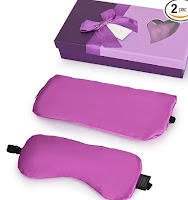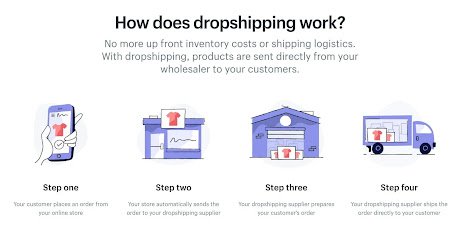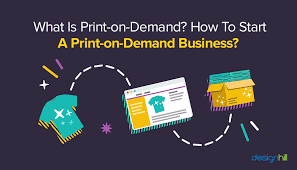In a previous post, we talked about affiliate marketing as a possible side gig to make you some extra money and that avenue is still a viable one. Affiliate marketing requires no money to start, and can, if done correctly, make you quite a lot of money. That said, it is not the only way to make extra money for us retirees. We explored various ways to make extra money here, too.
In today's digital era, entrepreneurs and creative individuals are exploring innovative ways to start their own online businesses. Two popular methods that have gained significant traction are drop shipping and print on demand. We will look into the inner workings of both strategies, outlining the step-by-step processes involved, as well as exploring how they generate revenue. So, let's dive in and uncover the secrets behind successful drop shipping and print on demand ventures.
Drop Shipping: A Profitable E-commerce Model
This model is widely used and accepted by many. It does require work on your part because it is not a get rich quick scheme. Basically there are two issues that will determine if you will be successful or not and those are your choice of niche or product and how you advertise and get traffic to your store online. Getting traffic is the single biggest hurdle anyone faces when they want to start making money online. Unless you are a guru or influencer, you too will struggle to get people's eyes on your site and to get people to pull out their wallets to buy what you offer. It can be done, but it takes time and effort on your part which is why most people fail at drop shipping. They quit before they find that spot where success starts.
1. Understanding Drop Shipping:
Drop shipping is an e-commerce fulfillment model where online retailers (drop shippers) don't physically stock the products they sell. Instead, they partner with suppliers who handle inventory management and order fulfillment.
Think Amazon FBA here; or think about a partnership with a major supplier such as Temu or Alibaba, where you arrange the sales for their products and they manage the fulfillment, collect the cash, and send you your part. This type of business, though simple, requires strong business skills to manage and maintain.
2. Step-by-Step Process of Drop Shipping:
a. Research and Select a Niche: Identify a niche market with sufficient demand and profit potential. This step is absolutely essential. Make very sure that your choice of niche is viable by doing your due diligence to ensure a market for your product(s). If you skip this step, you are doomed to fail.
b. Find Reliable Suppliers: Establish partnerships with reputable suppliers who offer competitive prices and reliable shipping. Once you have decided on your product, then you research the various suppliers of the product to determine which one will work the best for you. Things like reputation, reliability, support, cost-effectiveness, etc. will all come into play when you examine a supplier.
c. Set Up an Online Store: Create an e-commerce website or utilize platforms like Shopify to showcase your products. This sounds complicated, but it really isn't. There are so many platforms available today that will help you set up a store. The biggest hurdle will be getting your own domain name, which will cost you some money. It is always best for a business to have it's name secured, so you will need to buy a domain name for your store.
d. Curate Product Listings: Import product information, including descriptions, images, and prices, onto your online store. Most of this will come directly from your supplier, but you need to inject some of your own expertise into it instead of just repeating what they already have out there on the internet. Make sure you are making your listings customer oriented and telling them "what's in it for them."
e. Drive Traffic to Your Store: Utilize marketing strategies such as search engine optimization (SEO), social media marketing, and content marketing to attract potential customers. Driving traffic is the #1 show stopper for most internet store owners. Getting traffic sounds like it should be easy, you know, "if you build it they will come." But, unfortunately, that is not how it works. As of 2021, there were in excess of 1.8 billion websites online. Without traffic, you are simply a little guppy swimming in an ocean of sharks.
f. Receive Orders and Forward to Suppliers: Once customers place orders on your store, forward the details to your suppliers for fulfillment. Once a customer finds you and likes your product enough to buy it, make sure that your supplier knows about the order and will get it shipped as soon as possible. Don't let this one slip off the hook because they were slow and unresponsive. A customer is a valuable asset that you can't afford to lose.
g. Suppliers Handle Order Fulfillment: Suppliers package and ship products directly to your customers' doorsteps. You should put in place a way to follow the order from beginning to end. You need to make sure that your customer actually gets the order and you also need to make sure they are satisfied with both the product and your customer service. (Remember that word of mouth advertising is a rich source of traffic if the outcome is positive.)
h. Customer Support and After-Sales Service: Provide excellent customer support and address any inquiries or issues that arise. In today's economy and in the current state of our society, courtesy and customer service are things that can make you and your store stand out. Make sure you utilize those manners your mother taught you way back when. They still make a difference in today's world.
i. Profit Generation: The difference between the retail price and the wholesale price offered by suppliers is your profit margin. If you get this far, you should be a happy camper. Every penny you make in profit needs to be noted and accounted for when it comes to taxes, so start your bookkeeping right at the beginning of your endeavor.
3. Advantages of Drop Shipping:
a. Low Startup Costs: As you don't need to invest in inventory upfront, the initial costs are significantly lower compared to traditional retail. But, once again, lots of elbow grease and time may be required to get going.
b. Wide Product Variety: You can offer an extensive range of products without worrying about stocking them. At first, you may want to stick to a specific product or niche until you feel comfortable working in this model.
c. Location Flexibility: Drop shipping allows you to operate your business from anywhere with an internet connection. Don't be fooled by the gurus who say they are working on the beach. Probably they are not because internet service is still not reliable everywhere and until it is they have to work where they have it.
d. Scalability: With drop shipping, you can easily scale your business by adding new products or expanding into different niches. Once you get going, it is true that there is not limit on how you can grow your business. If this was to be a side-gig, you may just want to stay with one or two products and that is perfectly fine if it is making you extra cash.
Here are a few resources to check out about this:
Print on Demand: Empowering Creativity and Profitability
If you go anywhere online today, you will be bombarded with print on demand success stories that boast of wild amounts of money being made. I don't really believe the hype, but I do know that for a side-gig, print on demand can bring in some extra cash. There are many avenues you can explore in this type of business.
1. Understanding Print on Demand:
Print on demand (POD) is a business model that enables individuals to create and sell custom-designed products, such as apparel, accessories, and home decor items. Products are manufactured only after receiving orders, eliminating the need for inventory storage. I know I lost quite a few of you with the wording here. Create, in this instance, can mean actually create a design from scratch if you know how to do that, but it can also mean utilizing available resources to create designs for you. You have to decide which works for you.
2. Step-by-Step Process of Print on Demand:
a. Choose a Print on Demand Platform: Select a reputable POD platform like Printful, Printify, or Teespring. Be sure you read everything on the platform about doing business with them. All the fine print is there for a reason, so read it too. I know that we all like to just click read and go on, but here you really need to take the time to read and understand what they are saying. It can mean the difference between making money and losing money to you.
b. Design Creation: Create unique designs that resonate with your target audience using design software or hire a freelance designer. First, define who is your "perfect" customer and that will be who you use as your target audience. What type of design or article would they be interested in? For me, I would want to see products with dogs on it. For you, it could be golf. The options are endless, so unless you know who your customer will be, you may get lost online. Once you have that defined, there are many ways to legally get designs that will appeal to that customer including making a design yourself. Your job is to find the right platform, program, designer, etc. for your business.
c. Select Products: Choose the items you want to offer, such as t-shirts, hoodies, mugs, or phone cases. If you visit any of the print on demand platforms, you will quickly become inundated with so many choices of items to choose from. You really need to pick one or two items and stick to that at first. Don't go after every product they offer to begin with. Money can be made from just one type of item; or they would not be offering it.
d. Integrate with an E-commerce Platform: Connect your chosen POD platform with your online store or utilize the built-in selling features of the platform. In today's internet, most of the print on demand platforms will do this for you, but you have to have things already set up and ready to receive from them. An e-commerce platform is Etsy, Redbubble, Shopify, Wix, Woo-commerce, etc. You must decide which will be your e-commerce platform depending on things like cost, ease of use, integration to your printing platform, whether they help with traffic, etc.
e. Upload Designs and Customize: Upload your designs onto the platform and customize product options like color, size, and placement. This is the easiest part, but may take a large portion of your available time to do until you understand what exactly you want to say about each design.
f. Set Pricing: Determine the retail price by considering the production cost, desired profit margin, and market demand. It is tempting to want to arrange a big mark-up and make the profit margin large, but remember that you want sales and don't price yourself out of the market. Look for competitors to your designs and see what the market supports for prices.
g. Promote and Market: Utilize digital marketing techniques to drive traffic to your store and increase product visibility. Here again we get to the traffic issue. When you operate online, traffic is like the blood flowing in your veins. You MUST have traffic to be viable. This stumbling block can be the one to torpedo you unless you are open to learning more about getting traffic.
h. Receive Orders: When customers purchase products, the POD platform takes care of manufacturing, packaging, and shipping. This is the same as for drop-shipping.
i. Customer Support and After-Sales Service: Offer prompt and reliable customer support to enhance the overall shopping experience. Customer service and civility will win out always, so make that a part of your business.
j. Profit Generation: The profit is calculated based on the retail price minus the production and platform fees.
3. Advantages of Print on Demand:
a. Low Overhead Costs: Since products are manufactured only after receiving orders, there's no need to invest in inventory upfront.
b. Customization and Creativity: Print on demand allows you to showcase your unique designs and cater to specific customer preferences.
c. Scalability: You can easily scale your business by expanding your product offerings or targeting different niche markets.
d. Risk Mitigation: Print on demand eliminates the risk of unsold inventory, as products are created on-demand.
Here are a few resources about print on demand also:
Both of these businesses are excellent ideas for starting a side-gig in your retirement. They do not have to take over your life and become like a J-O-B. You are the determining factor in the size and amount of work you want to put into it and you are the final say on whether these will work for you.
By following the step-by-step processes outlined here, you can begin your journey towards building a profitable online business. Whatever you choose, remember to focus on providing exceptional customer experiences and make sure you are presenting quality items that you can stand behind.












